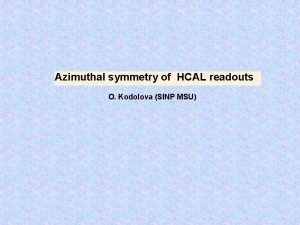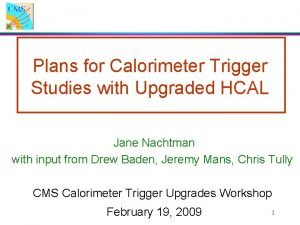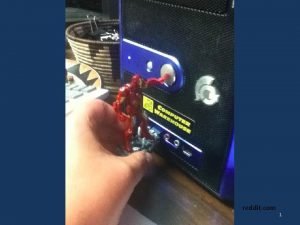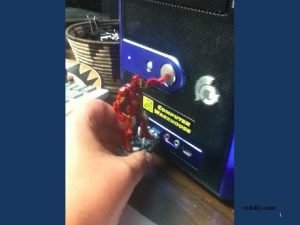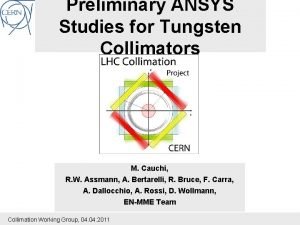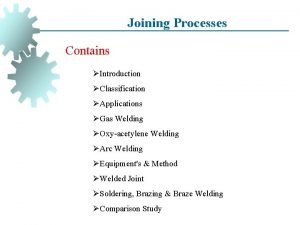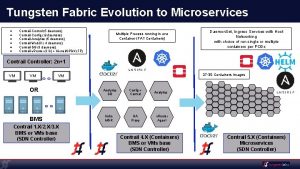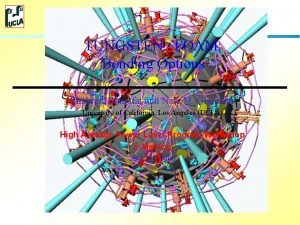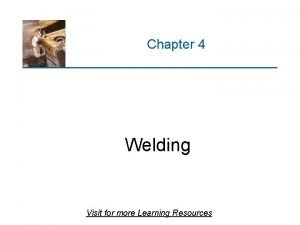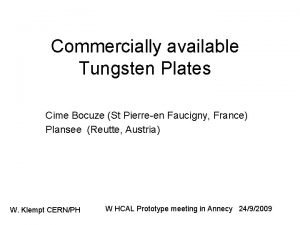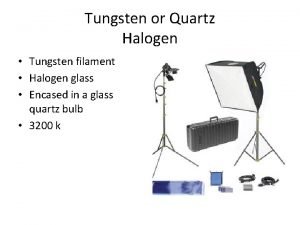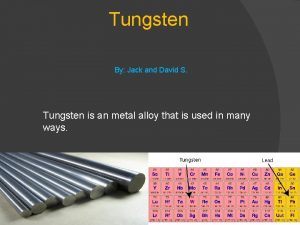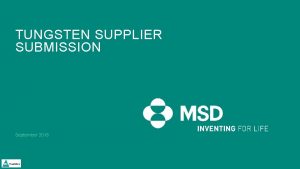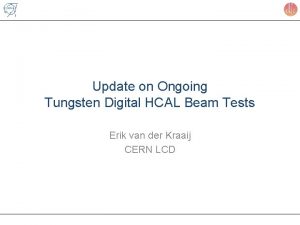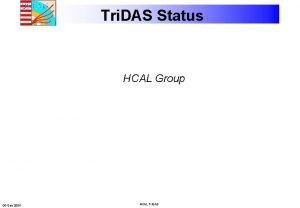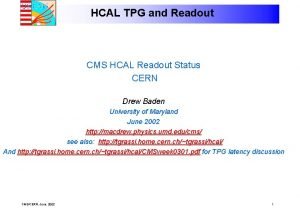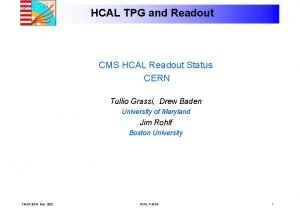Ideas on a Tungsten HCAL Prototype W Klempt











- Slides: 11

Ideas on a Tungsten HCAL Prototype W. Klempt / CERN Motivation Goals and Objectives Commercial available Tungsten Plates Workshop in Annecy Proposal for a W HCAL Prototype Conclusion CLIC 09 Workshop 15/10/09

Motivation • Physics at CLIC with a center of mass energy of 3 Te. V requires to build a calorimeter system with rel. small energy leakage. => Design value for λint ≥ 1 (ECAL) + 7 (HCAL) • Space available for barrel HCAL inside (reasonable sized) coil: Δr ≈ 1. 40 m => need to use a more dense material than Fe • Why not use W as absorber material in HCAL? ?

Motivation • No experience with W as absorber material in HCAL • λint (W) = 10 cm , X 0(W) = 0. 35 cm • λint (Fe) / λint (W) = 1. 7, X 0(Fe) / X 0(W) = 5 • For a W absorber: – less visible energy (ionization) – more neutrons (spallation) • PFA analysis requires very fine granularity in both ECAL and HCAL • For colorimeter design simulations need to be reliable and understood to a rather precise level.

Goals and Objectives for a W HCAL Prototype • Validate and adjust simulations for HCAL performances – – – Linearity / energy Resolution /energy Shower structure in comparison to Fe Time structure of signal (neutrons) Compare scintillator with gaseous detectors Experience with W plates Later – Other detector technologies – Combine with ECAL proto – …

Mechanical Properties of Tungsten Pure W INERMET 176* Steel 100 92. 5 - - Cu, Ni - Elasticity (Young) [GPa] 400 350 200 Density [g/cm 3] 19. 3 17. 6 7. 85 % Elongation at yield < 5** 5 30 -50 % Tungsten Alloying materials *Alloys used must be paramagnetic, **Tests required

Plate size and tolerances • Currently available plate sizes Pure Tungsten INERMET 1200 mm x 1600 mm 400 mm x 600 mm • Thickness of 10 mm is feasible for both • Flatness tolerance ca. 1. 5 mm – < 1 mm possible • Thickness tolerance ± 0. 5 mm – With machining ± 0. 1 mm (cost ↑)

Mini Workshop in Annecy on 24/9/09 • The LCD-CERN, CALICE-DESY and LAPP groups agreed to work together and construct a W-HCAL prototype starting 2010. • More collaborators should be found • The aim is to have first test beam measurements in autumn 2010

Proposal for a W HCAL Prototype • Start 2010 with a “small” prototype: – Start with ~20 W plates size 80 x 80 cm 2, 1 cm thick – Use as much as possible existing equipment from CALICE (detector planes, readout electronics, DAQ, mechanical infrastructure…. . ) – First test beam at PS/SPS in autumn 2010 – Later increase depth to 40 or more layers

Detectors to be used • In 2010 start with existing CALICE scintillator cassettes Overall size 90 x 90 cm 2 Central area equipped with small ( 3 x 3 cm 2 ) cells Equipped with readout and calibration

Future Detector Planes • Micromegas detector planes with a cell size of 1 x 1 cm 2 and digital read out • Scintillator planes with a cell size of 3 x 3 cm 2 over the whole surface and analog readout

Conclusion • Tungsten offers maybe the possibility to build a compact HCAL with fine granularity readout at CLIC. • No experience with W in an HCAL => need to validate W as absorber material in a prototype. • Use of existing equipment from CALICE enables to get to first experimental result already by next year
